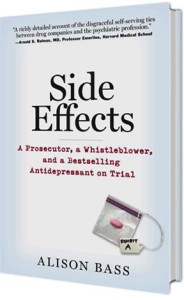Psychiatry is supposed to be all about disclosure, disclosing the dark secrets of one’s past to a professional in an effort to heal or, at the very least, figure out why one is in such psychic pain. But given the recent actions of the American Psychiatric Association, the largest trade group for psychiatrists in the U.S., one might get the impression that the profession is really all about censorship and obfuscation.
Remember when the Project on Government Oversight (POGO), as part of an effort to get the NIH to crack down on ghostwriting, released documents showing that a psychopharmacology handbook for primary care doctors, authored by then psychiatry kingpins Charles Nemeroff and Alan Schatzberg, had actually been ghost-written by a company hired by GlaxoSmithKline, the maker of the blockbuster antidepressant, Paxil? The New York Times broke the story last fall, relying on internal Glaxo documents obtained in the course of a lawsuit against the drug giant, and a number of other journalists, including myself, blogged about it — see here. The documents showed that Glaxo hired Scientific Therapeutics Information (STI) to prepare a draft of the textbook with the understanding that Glaxo could review the initial drafts before publication. The handbook itself, which was published in 1999 by the APA, essentially promoted Paxil, among other drugs, as a safe and effective treatment for anxiety and depression.
Sound familiar? As Side Effects reveals, that’s exactly how the initial drafts of the notorious Paxil study 329 were prepared — by the same company, STI, again under contract to Glaxo. In a remarkably similar arrangement, the authors of the Paxil study did not object to the draft’s positive wording and made only minor changes to the paper, which concluded that Paxil was safe and effective in treating depression in adolescents even though the actual data showed quite the opposite — see back story here. (In its later review of Paxil and other antidepressants before attaching black box warnings to them, the FDA labeled study 329 a “negative finding” because the study did not show statistical evidence of the drug’s effectiveness and did not accurately represent the extent of Paxil’s suicidal side effects among adolescents in the trial).
To get back to the story at hand, after the Times article was published, Nemeroff, who was drummed out of Emory for failing to disclose myriad financial ties to the drug industry and is now chair of psychiatry at the University of Miami, and Schatzberg, the dethroned chair of psychiatry at Stanford and a past president of the APA, called in their lawyers who insisted on several corrections to the Times piece, which I append here:
A headline on Nov. 30 with an article about SmithKline Beecham’s role in the publication of a book about treating psychiatric disorders overstated SmithKline’s actions. While documents show that SmithKline (now known as GlaxoSmithKline) hired a writing company for the book, they do not indicate that the company wrote the book for the authors, Dr. Charles B. Nemeroff and Dr. Alan F. Schatzberg. The article also described incorrectly, in some editions, events outlined in a letter from the writing company to Dr. Nemeroff. The correspondence proposed a timeline for the writing company to furnish the doctors and SmithKline with draft text and final page proofs for approval; the letter did not say that the company had already provided those materials for final approval. And the article misstated the context under which Dr. David A. Kessler, the former commissioner of the Food and Drug Administration, commented about the book’s production. The letter and other documents were described to him; he did not personally review the documents.
All well and good, but then the APA, probably in response to outraged queries from its members, wrote a self-serving and inaccurate piece about the whole affair in its news bulletin, Psychiatric News. Its bromide said the corrections “seemed to throw into doubt the central premises of the original article” and “seriously overstated the role of the writing company.” Neither of these allegations, of course, are true — the corrections appended to the Times article do not change the basic fact that the handbook was largely ghost-written by a company hired by Glaxo to promote Paxil and other antidepressants to primary care doctors.
Indeed, two prominent psychiatrists pointed that very truth out in a letter to the editor of Psychiatric News. While Ron McMillen, a spokesman for the APA, argued in the PN article that Nemeroff and Schatzberg were actively involved “in every stage of the book’s development,” the letter’s authors note that McMillen did not venture to say that Nemeroff and Schatzberg “wrote the initial drafts — or indeed any drafts.” The letter notes:
“The released 49-page sample chapter draft provided by Diane Coniglio and Sally Laden, employees of Scientific Therapeutics Information (STI), is largely reproduced verbatim in the Handbook.
In their January 28, 2011 letter to the editor, Dr. Bernard Carroll, professor and chairman emeritus of the department of psychiatry at Duke University Medical Center, Dr. Robert Rubin, professor and vice chair of the department of psychiatry at the University of California, Los Angeles, and Leemon McHenry, a researcher at California State University, also called on the APA to release internal documents that might shed light how much influence Glaxo did have on the context and tone of the book and its role in approving drafts. The letter writers concluded, “This case highlights the need for disclosure if we ever are to understand the scale of corporate influence on academic publishing.”
Here’s where things really get absurd. After sitting on the letter for two months, Psychiatric News decided not to publish it. In an email to Carroll et al dated March 22, Cathy Brown, executive editor for the publication, wrote that the issue has been covered extensively already and “therefore, we will not be printing additional information about it at this time.”
How sad. Can it be that the APA is so fearful of its members’ reactions (or more likely, legal threats by Nemeroff and Schatzberg) that it cannot even run a short and well-reasoned letter to the editor? For an organization that represents a profession whose very modus operandi is based on disclosure and transparency, the APA’s track record of censorship and secrecy is unacceptable.



2 Comments